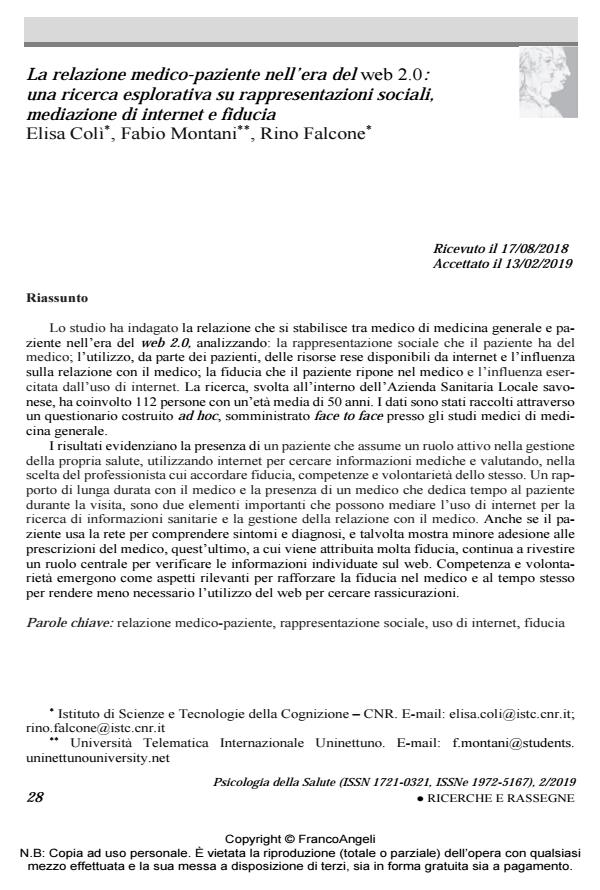La relazione medico-paziente nell’era del web 2.0: una ricerca esplorativa su rappresentazioni sociali, mediazione di internet e fiducia
Titolo Rivista PSICOLOGIA DELLA SALUTE
Autori/Curatori Elisa Colì, Fabio Montani, Rino Falcone
Anno di pubblicazione 2019 Fascicolo 2019/2
Lingua Italiano Numero pagine 25 P. 28-52 Dimensione file 293 KB
DOI 10.3280/PDS2019-002002
Il DOI è il codice a barre della proprietà intellettuale: per saperne di più
clicca qui
Qui sotto puoi vedere in anteprima la prima pagina di questo articolo.
Se questo articolo ti interessa, lo puoi acquistare (e scaricare in formato pdf) seguendo le facili indicazioni per acquistare il download credit. Acquista Download Credits per scaricare questo Articolo in formato PDF

FrancoAngeli è membro della Publishers International Linking Association, Inc (PILA)associazione indipendente e non profit per facilitare (attraverso i servizi tecnologici implementati da CrossRef.org) l’accesso degli studiosi ai contenuti digitali nelle pubblicazioni professionali e scientifiche
Lo studio ha indagato la relazione che si stabilisce tra medico di medicina generale e pa-ziente nell’era del web 2.0, analizzando: la rappresentazione sociale che il paziente ha del medi-co; l’utilizzo, da parte dei pazienti, delle risorse rese disponibili da internet e l’influenza sulla relazione con il medico; la fiducia che il paziente ripone nel medico e l’influenza esercitata dall’uso di internet. La ricerca, svolta all’interno dell’Azienda Sanitaria Locale savonese, ha coinvolto 112 persone con un’età media di 50 anni. I dati sono stati raccolti attraverso un que-stionario costruito ad hoc, somministrato face to face presso gli studi medici di medicina gene-rale. I risultati evidenziano la presenza di un paziente che assume un ruolo attivo nella gestione della propria salute, utilizzando internet per cercare informazioni mediche e valutando, nella scelta del professionista cui accordare fiducia, competenze e volontarietà dello stesso. Un rap-porto di lunga durata con il medico e la presenza di un medico che dedica tempo al paziente durante la visita, sono due elementi importanti che possono mediare l’uso di internet per la ri-cerca di informazioni sanitarie e la gestione della relazione con il medico. Anche se il paziente usa la rete per comprendere sintomi e diagnosi, e talvolta mostra minore adesione alle prescri-zioni del medico, quest’ultimo, a cui viene attribuita molta fiducia, continua a rivestire un ruolo centrale per verificare le informazioni individuate sul web. Competenza e volontarietà emergo-no come aspetti rilevanti per rafforzare la fiducia nel medico e al tempo stesso per rendere me-no necessario l’utilizzo del web per cercare rassicurazioni.
Parole chiave:Relazione medico-paziente, rappresentazione sociale, uso di internet, fiducia
Elisa Colì, Fabio Montani, Rino Falcone, La relazione medico-paziente nell’era del web 2.0: una ricerca esplorativa su rappresentazioni sociali, mediazione di internet e fiducia in "PSICOLOGIA DELLA SALUTE" 2/2019, pp 28-52, DOI: 10.3280/PDS2019-002002